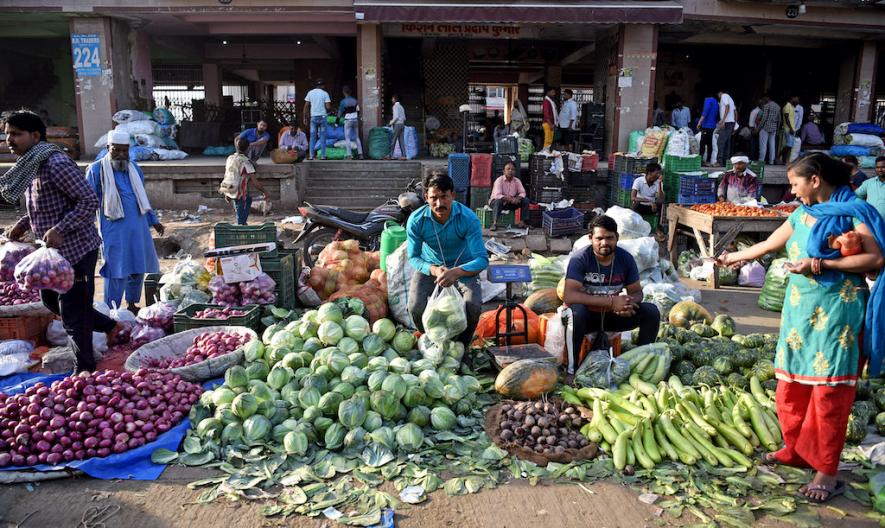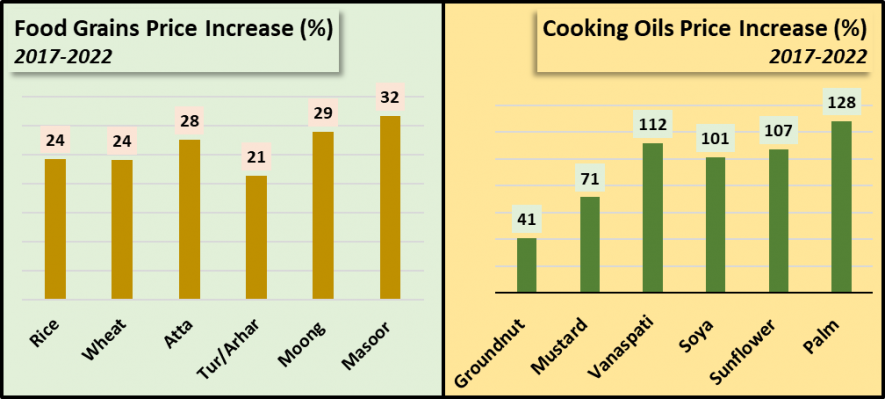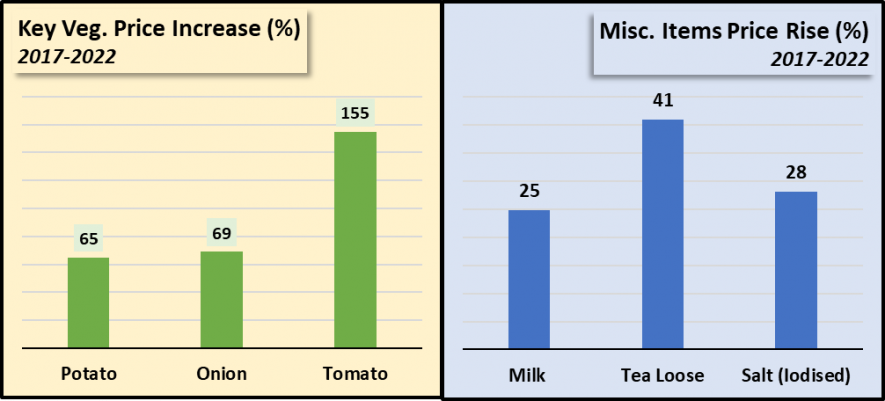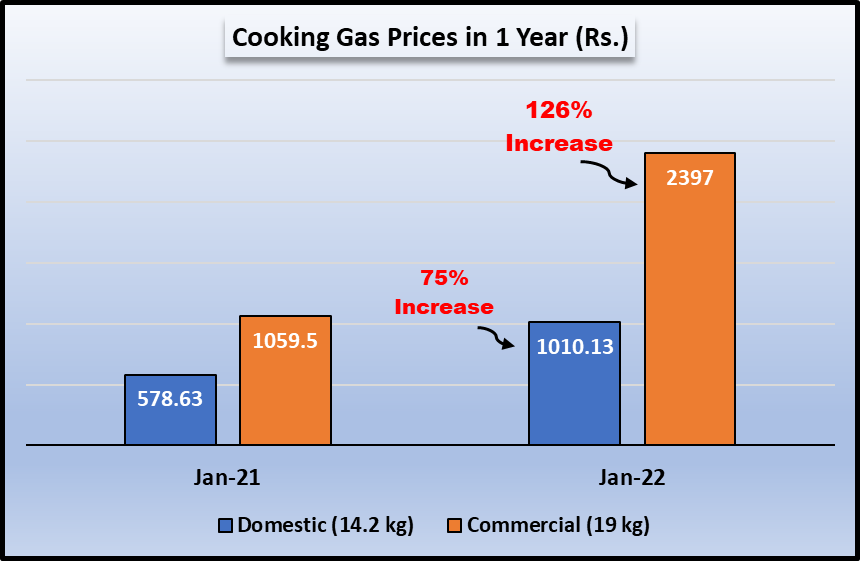Modi Govt Struggles to Control Runaway Price Rise

India is going through a deadly phase of inflation, especially in food items, that has devastated family budgets and left economic policy mandarins scrambling for remedial measures. As usual, the Narendra Modi-led government is displaying the usual signs that Indians have become quite used to – top-level meetings specially summoned by no less than the prime minister himself, directions to do this or that, headlines in a craven media. Then, there would be a sudden U-turn, a different decision altogether, headlines in the craven media again, and so on.
Wheat and atta (wheat flour) are a case in point. According to data collected from across the country by the central government’s Department of Consumer Affairs, average atta prices have increased from Rs 28.80 per kilogram on May 13, 2021, to Rs 33.14 on May 13, 2022 – that is a 13% increase in one year, the biggest in over a decade. Atta is a staple for many families, especially in the north and central India. The rise in atta prices will severely damage the family budgets of the poor. Unlike pulses or specific seasonal vegetables, a family cannot replace or stop using wheat till its prices cool down. This means that there is no escaping the damage such an onerous price rise is causing.
As reported by Newsclick earlier, wheat output has dipped, procurement has plummeted, and exports have gone up as the government encouraged traders to take advantage of tight global markets after the Ukraine war. After announcing on May 12 that government representatives will be visiting several countries to boost exports and setting a target of 10 million tonnes of wheat export in the coming months, the clueless government announced on May 14 that wheat export will be banned immediately to ensure food security.
But meanwhile, the price situation has been steadily worsening.
Coupled with the ongoing price rise in some other essential commodities, especially cooking oils, distress due to price rise is rapidly reaching unbearable scales. Milk is selling at above Rs 50 per litre. Most widely used cooking oils are being sold at nearly Rs 200 per litre. Some of the vegetables are going through a seasonal spike that takes them out of the common citizen’s reach. For example, potatoes are being sold at over Rs 22 per kilogram, up by 26% over the same time last year, while tomato prices have more than doubled, reaching Rs 38.26 per kilogram.
Price Rise in Past Five Years
Compared to five years ago, prices have zoomed up to intolerable heights, as shown in the charts below.

(Data from Department of Consumer Affairs)
While rice and wheat prices have increased by 24%, atta price has gone up by 28%. Some pulses like tur/arhar, moong, and masoor have also increased by 20-30%. But what has hurt the most is the skyrocketing prices of cooking oils, many of which have doubled as shown above.
After five straight years of record food grain harvests, the Modi government could only see profits for traders. In 2020, under cover of the raging pandemic, they tried to facilitate private traders by bringing laws to dismantle the procurement system and allow free trade, stocking, and pricing. A year long struggle by furious farmers forced the government to retreat. But this year, the government thought it would encourage free export and take advantage of the high global prices of wheat. Meanwhile, domestic prices caught fire – hence this scrambling to curtail exports.
Price rise is not restricted to food grains and cooking oils alone. As the chart below shows, prices of the ‘Big Three’ among vegetables – potatoes, onions, and tomatoes – have risen dramatically in the past five years. Of course, there are seasonal ups and downs, but the spikes and crashes are an indication of a policy paralysis about vegetable supply, which is always on the brink.

(Data from Department of Consumer Affairs)
Also, note that some miscellaneous but essential items are also showing severe inflationary pressure. While milk prices have gone up by 25%, loose tea leaves have risen by 41%, and even salt has increased by 28%.
Cooking Gas and Petrol/Diesel
The story of this robbery-by-inflation does not end with this, unfortunately. Cooking gas (LPG) prices have increased by an incredible Rs 431.50 in just one year for the domestic 14.2 kg cylinder – that is an increase of 76%. Meanwhile, the commercial cylinder of 19 kg now comes for Rs 2,397, up by 126% from Rs 1059.5 last year. (See chart below)

Meanwhile, petrol and diesel prices continue to be jacked up by the central government. The Modi government kept the prices frozen for 137 days before the Assembly elections in Uttar Pradesh, Punjab, and other states. No sooner were these elections over, the prices were raised successively for several days. In the past one year, petrol prices have gone up by over 20% and diesel prices by nearly 17%, according to daily data released by the Petroleum Planning & Analysis Cell (PPAC) of the petroleum and natural gas ministry. The rise in the prices of these fuels has a cascading effect on all essential commodities since it hikes up transportation costs.
What’s Going to Happen Now?
April data on the Consumer Price Index has shown that retail inflation touched 7.79%, an eight-year high. Rural inflation was higher at 8.38%. Meanwhile, food items’ inflation clocked in at 8.38%, with rural areas showing 8.5%. Clearly, the price rise is raging and uncontrollable as of now.
Wholesale prices have risen by a record 14.55%, according to the last data released on April 18. Usually, wholesale prices get translated to consumer or retail prices after a few months' lag. Fuels (petrol, diesel) form a hefty chunk of the wholesale price index (WPI), and their increase is going to affect the prices of most other commodities in the coming months.
The held over wheat brought at higher prices by traders (with export in mind) will now get routed back to the domestic open market – at higher prices. People who are already deprived of wheat in their ration quotas will be forced to buy up the high-priced grain from open markets.
In short, the immediate future portends a dire price situation. With the Modi government displaying its usual attitude of brazening it out in the time of crisis, the situation could be ripe for another and more devastating blow to the already distressed living standards of the people.
The only ways of addressing this runaway inflation are for the government to clamp down on profiteering and hoarding, expand the public distribution system (PDS) to bring various commodities into its ambit (like cooking oils, vegetables, milk, etc.), and to step up wheat as well as other grains’ procurement. Importantly, the government needs to slash excise duties on petrol and diesel so that prices are brought down. Similarly, cooking gas prices need to be controlled and subsidies restored. Is the government willing to do all this? Or will it throw the people to the wolves?
Get the latest reports & analysis with people's perspective on Protests, movements & deep analytical videos, discussions of the current affairs in your Telegram app. Subscribe to NewsClick's Telegram channel & get Real-Time updates on stories, as they get published on our website.






















